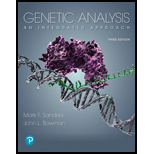
Genetic Analysis: An Integrated Approach (3rd Edition)
3rd Edition
ISBN: 9780134605173
Author: Mark F. Sanders, John L. Bowman
Publisher: PEARSON
expand_more
expand_more
format_list_bulleted
Concept explainers
Textbook Question
Chapter 1, Problem 5P
Define the terms allele, chromosome, and gene and explain how they relate to one another. Develop an analogy between these terms and the process of using a street map to locate a new apartment to live in next year (i.e., consider which term is analogous to a street, which to a type of building, and which to an apartment floor plan).
Expert Solution & Answer
Want to see the full answer?
Check out a sample textbook solution
Students have asked these similar questions
What is the difference between Uniporters, Symporters and Antiporters? Which of these are examples of active transport?
What are coupled transporters?
What are “domains” and how do they aid in protein function?
Chapter 1 Solutions
Genetic Analysis: An Integrated Approach (3rd Edition)
Ch. 1 - 1. Genetics affects many aspects of our lives....Ch. 1 - 2. How do you think the determination that DNA is...Ch. 1 - 3. A commentator once described genetics as “the...Ch. 1 - All life shares DNA as the hereditary material....Ch. 1 - Define the terms allele, chromosome, and gene and...Ch. 1 - 6. Define the terms genotype and phenotype, and...Ch. 1 - 7. Define natural selection, and describe how...Ch. 1 - Describe the modern synthesis of evolution, and...Ch. 1 - What are the four processes of evolution? Briefly...Ch. 1 - Define each of the following terms: a....
Ch. 1 - 11. Compare and contrast the genome, the proteome,...Ch. 1 - With respect to transcription describe the...Ch. 1 - Plant agriculture and animal domestication...Ch. 1 - Briefly describe the contribution each of the...Ch. 1 - If thymine makes up 21% of the DNA nucleotides in...Ch. 1 - What reactive chemical groups are found at the 5...Ch. 1 - Identify two differences in chemical composition...Ch. 1 - What is the central dogma of molecular biology?...Ch. 1 - A portion of a polypeptide contains the amino...Ch. 1 - The following segment of DNA is the template...Ch. 1 - 23. Fill in the missing nucleotides (so there are...Ch. 1 - 24. Suppose a genotype for a protein-producing...Ch. 1 - Prob. 25PCh. 1 - 26. Four nucleic acid samples are analyzed to...Ch. 1 - 27. What is meant by the term homology? How is...Ch. 1 - 28. If one is constructing a phylogeny of reptiles...Ch. 1 - 29. Consider the following segment of...Ch. 1 - 30. Ethical and social issues have become a large...Ch. 1 - 31. In certain cases, genetic testing can identify...Ch. 1 - 32. What information presented in this chapter and...Ch. 1 - 33. It is common to study the biology and genetics...
Additional Science Textbook Solutions
Find more solutions based on key concepts
True or false? Some trails are considered vestigial because they existed long ago.
Biological Science (6th Edition)
Calculate the lattice energy of CaCl2 using a Born-Haber cycle and data from Appendices F and L and Table 7.5. ...
Chemistry & Chemical Reactivity
Give the IUPAC name for each compound.
Organic Chemistry
Why do scientists think that all forms of life on earth have a common origin?
Genetics: From Genes to Genomes
Describe the role and impact of microbes on the earth.
Microbiology Fundamentals: A Clinical Approach
Knowledge Booster
Learn more about
Need a deep-dive on the concept behind this application? Look no further. Learn more about this topic, biology and related others by exploring similar questions and additional content below.Similar questions
- What are intrinsically disordered proteins, and how might they be useful for a living system?arrow_forwardWhat are Amyloid Fibrils? What biological functions are these known to perform?arrow_forwardHow do histamine and prostaglandins help in the mobilization of leukocytes to an injury site? What are chemotactic factors? How do they affect inflammation process?arrow_forward
- Compare and contrast neutrophils and macrophages. Describe two ways they are different and two ways they are similar.arrow_forwardDescribe the effects of three cytokines (not involved in the initial inflammation response). What cells release them?arrow_forwardDescribe activation of helper T cells or cytotoxic T cellsarrow_forward
- Compare and contrast MHC 1 and MHC 2. Describe two way they are different and two ways they similar including how they are used in antigen presentation.arrow_forwardDescribe two antimicrobial properties of the skin.arrow_forwardDescribe how the inflammation response starts including the sentinel cells and the chemicals involved. How do pathogens trigger the response particularly in the skin?arrow_forward
- How does complement promote the immune response? Describe three waysarrow_forwardWhich of the following is not a possible mechanism for autoimmunity? Select one: A. Abnormal expression of MHC II molecules in non-antigen-presenting cells B. Activation of polyclonal B cells C. Polymorphism of HLA alleles D. Molecular mimicry E. Release of sequestered antigensarrow_forwardWRITTEN WORK 3: NON-MENDELIAN GENETICS Part A: Complete the Punnett square and calculate for the probability of genotype and phenotype. i i Genotype: Phenotype: 08:55arrow_forward
arrow_back_ios
SEE MORE QUESTIONS
arrow_forward_ios
Recommended textbooks for you
 Human Heredity: Principles and Issues (MindTap Co...BiologyISBN:9781305251052Author:Michael CummingsPublisher:Cengage Learning
Human Heredity: Principles and Issues (MindTap Co...BiologyISBN:9781305251052Author:Michael CummingsPublisher:Cengage Learning

Human Heredity: Principles and Issues (MindTap Co...
Biology
ISBN:9781305251052
Author:Michael Cummings
Publisher:Cengage Learning
Genetic Variation and Mutation | 9-1 GCSE Science Biology | OCR, AQA, Edexcel; Author: SnapRevise;https://www.youtube.com/watch?v=bLP8udGGfHU;License: Standard YouTube License, CC-BY